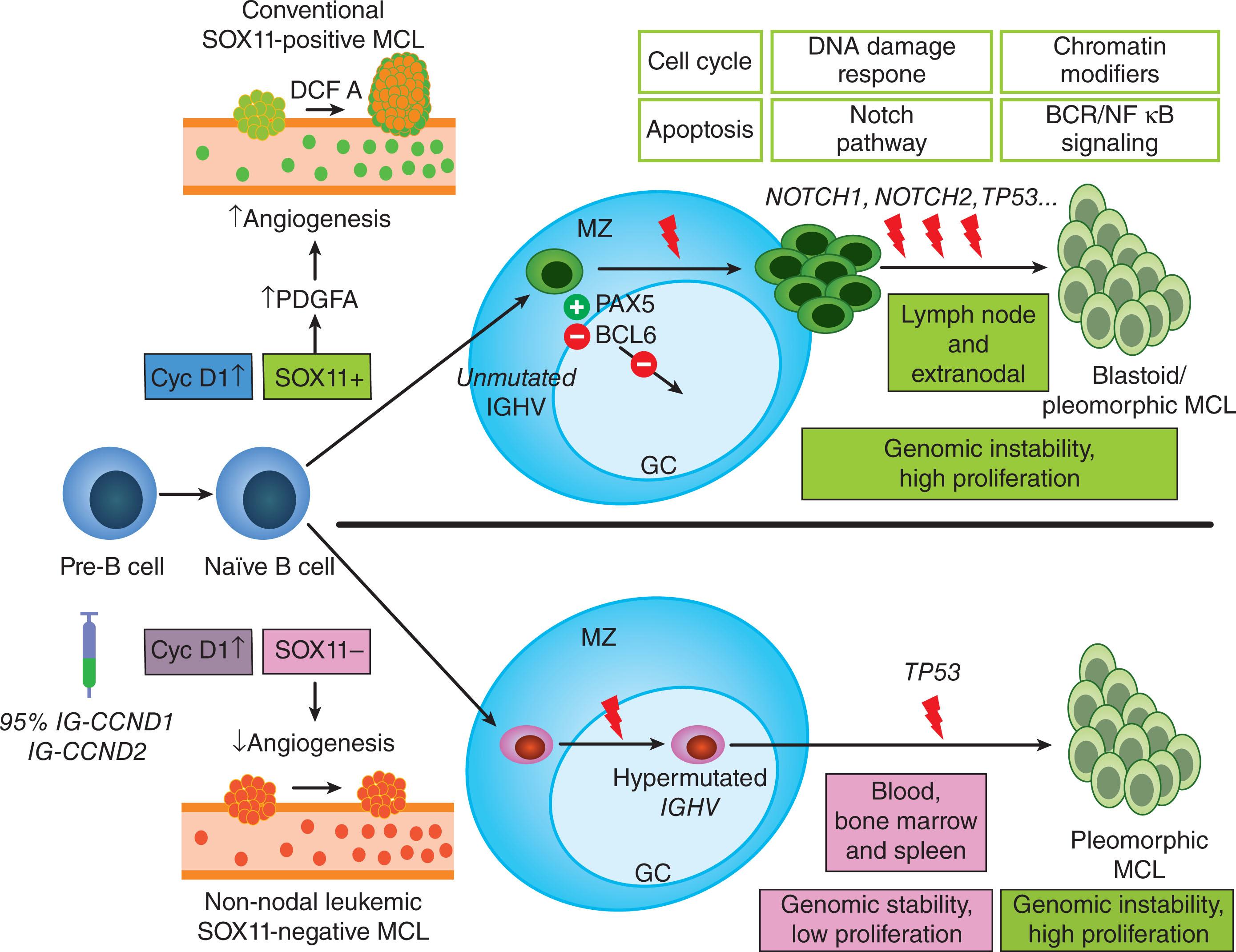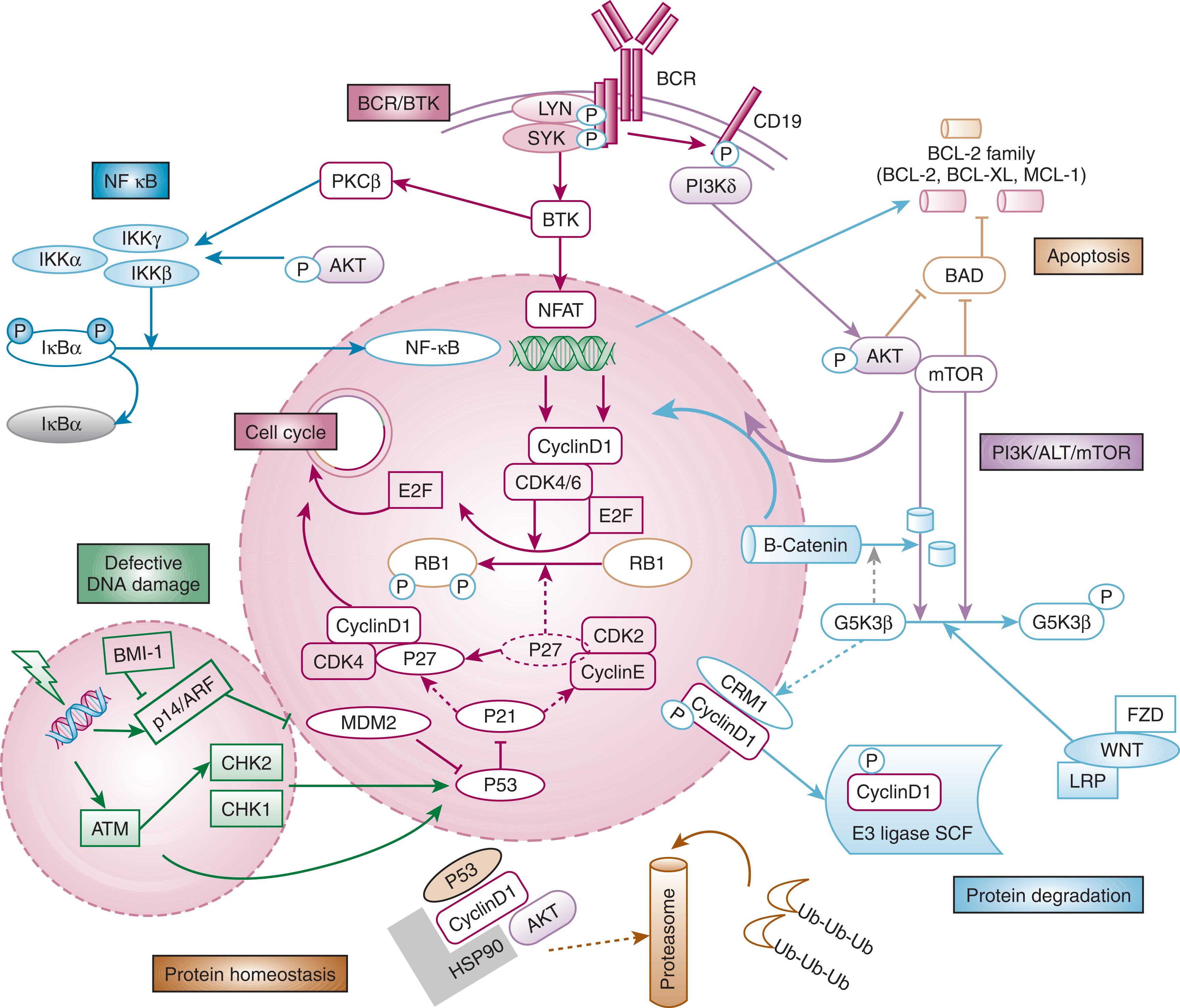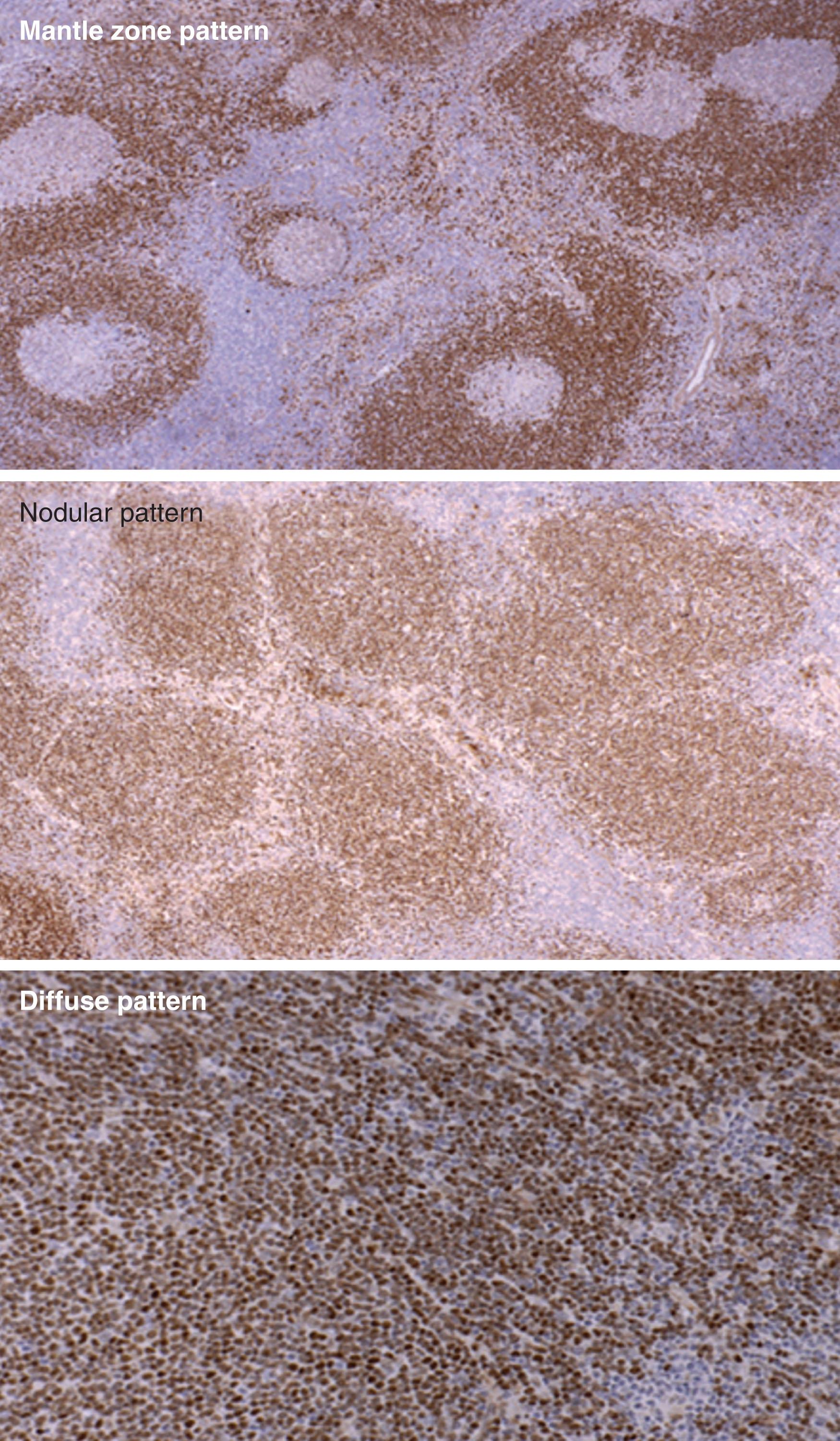Physical Address
304 North Cardinal St.
Dorchester Center, MA 02124
Mantle cell lymphoma (MCL) is a distinct subtype of mature B-cell non-Hodgkin lymphoma (NHL) that accounts for 5% to 10% of all NHL. Although a subset of patients with MCL may have an indolent course, MCL is generally an aggressive NHL. In the 1970s, the Kiel classification used the terminology centrocytic lymphoma to describe MCL, whereas Berard and Dorfman categorized it as lymphocytic lymphoma of intermediate differentiation . In the 1980s, the term mantle-zone lymphoma was used to denote a distinct subtype of MCL, characterized by the proliferation of atypical, small lymphoid cells with wide mantles around benign germinal centers (GCs). In the Revised European–American Lymphoma classification in 1994, 2001, 2008, and 2016, the WHO classification of tumors of hematopoietic and lymphoid tissues recognized MCL as a distinct disease under mature B-cell lymphomas. In recent years, with the recognition as a distinct entity, significant progress has been made toward understanding the underlying pathogenesis of MCL and translating that knowledge to design more effective therapies.
MCL represents 6% to 10% of all lymphomas and is two- to sevenfold more common in men than women and almost twofold more common in people of European ancestry than African Americans. The average age at diagnosis varies between 60 and 70 years. The annual incidence is approximately four to eight cases per million population in the United States and Europe.
MCL, characterized by an alteration in the regulation of the cell cycle, demonstrates cyclin D1 overexpression and increased replication. The tumor cells also demonstrate decreased response to DNA damage and resistance to apoptosis. The tumor cells originate from pre-B cells in the bone marrow that can follow at least two different molecular pathways of development.
The classic MCL originates from a naïve B cell that has not entered the follicular GC but has SOX11 expression, lambda light chain restriction, and limited or no immunoglobulin heavy chain variable (IgVH) somatic mutations. SOX11 expression is associated with the activation of histone marks and absence of DNA methylation. The second subset of MCL, an indolent form typically limited to peripheral blood, bone marrow, and spleen, originates from post-GC B cells. This MCL subset has frequent IgVH mutations, typically lacks SOX11 expression, and has kappa light chain restriction. A few studies have demonstrated a correlation between SOX11 expression and aggressive tumors with high serum levels of lactate dehydrogenase (LDH) and high Ki-67 index. Conversely, SOX11-negative MCL may occasionally acquire complex karyotype and TP53 alterations, transforming into an aggressive tumor ( Fig. 86.1 ).

The three most common recurrent mutations in MCL involve CCND1 (also known as cyclin D1, BCL1, or PRAD1), TP53, and ataxia-telangiectasia mutated ( ATM ) genes. The vast majority of MCL have the reciprocal translocation, t(11;14) (q13;q23), which juxtaposes CCND1 gene to the immunoglobin heavy-chain locus. The consequent overexpression of CCND1 gene, located at 11q13, encodes cyclin D1 protein. Cyclin D1 protein, which is not expressed in normal lymphocytes, is expressed in virtually all MCL and at a lower level in Burkitt lymphoma and acute lymphoblastic lymphoma (ALL). A few cells with t(11;14) have been found in the blood of 1% to 2% of healthy individuals. Therefore, cyclin D1 overexpression is not sufficient for the transformation of normal B cells to MCL, rather it is thought to represent an early genetic event. Interestingly, the close physical proximity of the chromosomal regions of the IgVH and CCND1 loci in the nucleus of immature lymphoid B cells may facilitate the occurrence of recurrent translocations. Furthermore, colocalization and interaction of IgVH-CCND1 chromosomal segment and a transcription factor called nucleolin near the perinucleolar area leads to the transcription of cyclin D1 protein. Cyclin D1 protein then regulates the G1 phase by binding to cyclin-dependent kinase (CDK) 4 and CDK6. The cyclin D1-CDK complex phosphorylates retinoblastoma 1 (RB1), resulting in a release of E2F transcription factor and transition of a cell from G1 to S phase. Additionally, the CDKN2A gene on chromosome 9p, which regulates INK4a protein, is deleted in 20% to 30% of highly proliferating MCL. The INK4a protein inhibits CDK4 and CDK6 and thus maintains the RB1 protein in its active, antiproliferative state. INK4a is frequently deleted in MCL and cooperates with CCND1 gene. Therefore, the CDKN2A-INK4a-CDK4-RB1 pathway is dysregulated in patients with MCL, particularly those with blastoid histology.
Recent studies have described cyclin D1-negative MCL cases that demonstrate pathologic features and gene expression profile, similar to cyclin D1–positive MCL. Cyclin D1–negative MCL is associated with the dysregulation in the expression of the following genes (often due to epigenetic changes): overexpression of cyclin D2 or D3; decreased CDK inhibitor 1B (CDKI1B or p27); upregulation of cyclin E; or inactivation of RB gene. CDKI1B protein regulates the cell progression from G1 to S phase by inhibiting the cyclin E/CDK2 complex (the latter also inactivates the RB protein). Although the diagnosis of cyclin D1–negative MCL is uncommon and requires caution, these cases highlight the relevance of the oncogenic dysregulation of the cell cycle, especially of the G1 phase in the pathogenesis of MCL.
Some patients with aggressive MCL, particularly the blastoid variant, have an increased number of chromosomal abnormalities, such as complex karyotype and tetraploidy. The accumulation of chromosomal abnormalities suggests alterations in the DNA damage response pathways. TP53 mutation and deletion or point mutation of the ATM gene (located at 11q22–q23) are recurrent mutations in MCL. TP53 mutations, associated with alterations of 17p chromosomal segment, are present in 10% to 28% of MCL cases. These point mutations are frequently missense mutations that compromise normal p53 expression. The TP53 tumor suppressor gene normally regulates the cell cycle, DNA repair, apoptosis, senescence, and autophagy through transcription-dependent and independent pathways. Disruption in TP53-dependent apoptosis has also been linked to deletion, mutation, or silencing of BIM and NOXA genes. The latter two genes transcribe proapoptotic proteins important in Bax/Bak-mediated cytochrome C release, which is essential to apoptosis. TP53 expression is also inhibited by the binding of PAX5 transcription factor to the TP53 promoter. PAX5 is upregulated by SOX11 in a significant number of patients with MCL. PAX5 represses PRDM1/BLIMP1 and negatively regulates differentiation of early lymphoid progenitors to plasma cells. Therefore, the SOX11-PAX5-PRDM1/BLIMP1 axis suppresses B-cell differentiation to plasma cells and plays an important role in the pathogenesis of MCL. MDM2 is another protein overexpressed in about 16% of MCL and mediates polyubiquitination and degradation of p53. This function of MDM2 protein is prevented by ARF protein, also known as p14 (encoded by CDKN2A gene). In MCL, however, the homozygous deletion of the CDKN2A gene allows MDM2-mediated degradation of TP53 and dysregulation of apoptotic pathways.
Inactivation of the ATM gene, detected in about 40% of MCL, facilitates genomic instability by impairing responses to DNA damage. Intriguingly, the inactivation of ATM, perhaps an early phenomenon in MCL, is not commonly seen in other lymphomas—except in T-cell prolymphocytic leukemia. ATM encodes the PI3K protein, which phosphorylates p53, promoting its stabilization and transcriptional activation, therefore leading to cell-cycle arrest, DNA repair, or apoptosis. Consequently, inactivation of ATM causes genomic instability by inactivation of p53. Despite having similar pathogenic significance, ATM mutations do not impact overall survival, whereas TP53 mutations do predict for worse survival. In addition, ATM may play a role in activation of the nuclear factor kappaB (NFκB) by phosphorylation of the NFκB inhibitor, IkappaB. The NFκB-signaling regulates transcription factors that activate numerous genes involved in cell survival, apoptosis, and cell migration. Its persistent activity is associated with tumor formation, tumor growth, metastasis, and drug resistance, in B-cell lymphomas and other cancers. Notably, the PI3K-AKT pathway is upstream of the mammalian target of rapamycin (mTOR), which in turn is upstream of cyclin D1, CDKI1B, and other regulatory proteins. Conversely, CHK2 and CHK1 are kinases downstream of ATM and prevent cell-cycle progression in response to ATM. Downregulation or mutations of CHK2 and CHK1 are also commonly seen in MCL.
Wnt canonical and Sonic Hedgehog (SHH) pathways are also altered in MCL. The Wnt canonical pathway, via β-catenin and important for normal cell growth and development, is constitutively activated in a subset of MCL and may promote tumor growth. Similarly, SHH-GLI-signaling molecules such as PTCH and SMO receptors, as well as GLI1 and GLI2 transcription factors, are expressed in MCL and may contribute to the proliferation of MCL.
Lastly, dysregulation of the B-cell receptor (BCR), a key player of normal B-cell differentiation and development, is involved in the pathogenesis of MCL. Activation of BCR-associated kinases (spleen tyrosine kinase [SYK], Bruton tyrosine kinase [BTK], and protein kinase C-beta [PKC-β]) is observed in MCL. BTK, a member of the Tec family of nonreceptor protein tyrosine kinases, has a well-defined role in the constitutively activated BCR signaling pathway in MCL. Amplification and overexpression of SYK have been found in a subset of MCL. SYK, LYN, and BTK are frequently phosphorylated in MCL, suggesting activation of the BCR pathway. Therefore, the BCR pathway appears to contribute to the growth and survival of MCL cells. The signaling pathways that contribute to the pathogenesis are summarized in Fig. 86.2 .

The early symptoms sometimes include fever, night sweats, unexplained weight loss, lymphadenopathy, and splenomegaly. Typically, the majority of patients present at an advanced stage (III or IV) with lymphadenopathy, hepatomegaly, splenomegaly, and bone marrow involvement. Splenomegaly is noted in 40% of patients and approximately 50% of patients present with circulating lymphoma cells. MCL also tends to involve extranodal sites, especially in the gastrointestinal (GI) tract. Involvement of the GI tract, frequently in the form of lymphomatous polyposis, can be detected in up to 90% of patients; however, many patients do not have any pertinent GI symptoms. During disease progression, MCL can infiltrate other organs including the respiratory tract, breast, or orbit. Involvement of the central nervous system (CNS) is rare but may be relatively more common with blastoid MCL and relapsed disease.
Cytopenias are typically present secondary to bone marrow involvement and/or splenomegaly, whereas autoimmune cytopenias are rare. Elevation of LDH and uric acid correlates with tumor burden. Liver function tests may be abnormal if there is hepatic involvement. Other findings include elevated beta 2-microglobulin and, rarely, hypogammaglobulinemia or monoclonal gammopathy.
Histologically, the 2016 WHO classification describes classic MCL as a monomorphic proliferation of small- to medium-sized lymphoid cells, with an irregular nuclear border, dispersed chromatin, and inconspicuous nucleoli. The architectural patterns may include a vaguely nodular and diffuse mantle zone or, rarely, follicular growth pattern. Infrequent cases, referred to as in situ MCL, may exclusively involve the inner mantle zones or narrow mantles. Histologic transformation to large B-cell lymphoma does not occur; however, MCL can have several morphologic variants, including aggressive blastoid and pleomorphic variants ( Fig. 86.3 ).
Blastoid variant: lymphoma cells have a high mitotic rate (20 to 30 per 10 high-power fields) and dispersed chromatin; frequently resembles lymphoblasts.
Pleomorphic variant: cells have different forms including frequent large cells, pale cytoplasm, oval to irregular nuclear border, and often prominent nucleoli.
Small cell variant: cells are small and round with clumped chromatin; frequently resembles small lymphocytic lymphoma (SLL).
Marginal zone-like variant: this variant has clusters of marginal zone-like or monocytoid B cells, with abundant pale cytoplasm.

Become a Clinical Tree membership for Full access and enjoy Unlimited articles
If you are a member. Log in here